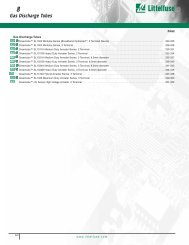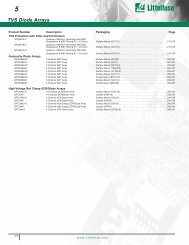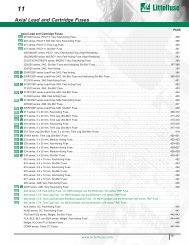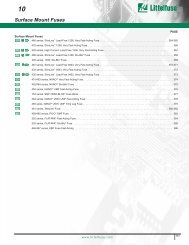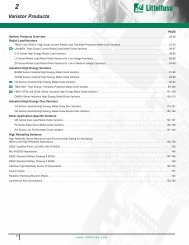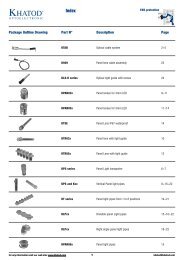ALUMINUM ELECTROLYTIC CAPACITORS
ALUMINUM ELECTROLYTIC CAPACITORS
ALUMINUM ELECTROLYTIC CAPACITORS
You also want an ePaper? Increase the reach of your titles
YUMPU automatically turns print PDFs into web optimized ePapers that Google loves.
PRECAUTIONS AND GUIDELINES<br />
by mea sur ing impedance and separating factors. Also, the<br />
AC ca pac i tance de pends upon frequency, voltage and other<br />
measuring meth ods. In fact, JIS C 5101 prescribes that the<br />
series capacitive factor of an equivalent series( )<br />
circuit shall be the ca pac i tance measured at a frequency of<br />
120Hz and applying a max i mum AC voltage of 0.5V rms with<br />
a DC bias voltage of 1.5 or 2.0V to aluminum electrolytic capac<br />
i tors. The capacitance of an aluminum elec tro lyt ic ca pac i -<br />
tor becomes smaller with in creas ing frequency. See the typ i -<br />
cal behavior shown be low.<br />
Capacitance Change (%)<br />
20<br />
10<br />
0<br />
-10<br />
-20<br />
-30<br />
-40<br />
-5<br />
10 100<br />
1k 10k<br />
Frequency (Hz)<br />
The capacitance value is highly dependent upon tem per a ture<br />
and frequency. As the temperature de creas es, the ca pac i -<br />
tance becomes smaller. See the typical be hav ior shown below.<br />
Capacitance Change (%)<br />
20<br />
15<br />
10<br />
5<br />
0<br />
-5<br />
-10<br />
-15<br />
Capacitance VS. Frequency<br />
-20<br />
-40 -20 0 20 40 60 80 100 120<br />
Temperature (C)<br />
Temperature Characteristics of Ca pac i tance<br />
On the other hand, DC capacitance, which can be measured<br />
by ap ply ing a DC voltage, shows a slightly larger value than<br />
the AC capacitance at a normal temperature and has the fl atter<br />
char ac ter is tic over the tem per a ture range.<br />
tane(tangent of loss angle or dissipation factor):<br />
The tanE is expressed as the ratio of the resistive com po nent<br />
(RESR) to the capacitive reactance (1/ωC) in the equiv a lent<br />
se ries circuit. Its measuring conditions are the same as the<br />
ca pac i tance.<br />
RESR LESL C<br />
tanE=RESR/ (1/ωC) =ωC RESR<br />
Where : RESR=ESR at 120Hz<br />
ω =2πf<br />
f =120Hz<br />
1/ωC E<br />
RESR<br />
The tanE shows higher values as the measured frequency<br />
in creas es and the measured temperature decreases.<br />
(5/10)<br />
tanE<br />
tanE<br />
100<br />
10<br />
1<br />
0.1<br />
100 1k 10k 100k<br />
Frequency (Hz)<br />
tanE VS. Frequency<br />
1<br />
0.1<br />
0.01<br />
-60 -40 -20 0 20 40 60 80 100<br />
Temperature (C)<br />
Temperature Characteristics of tanE<br />
Equivalent series resistance (ESR):<br />
The ESR is the series resistance consisting of the aluminum<br />
ox ide lay er, electrolyte/separator combination, and other re sis -<br />
tance related factors, foil length, foil surface area and oth ers.<br />
The ESR value depends upon the temperature. Decreasing<br />
the tem per a ture makes the resistivity of the electrolyte increase<br />
and leads to increasing ESR.<br />
As the measuring frequency increases, the ESR decreases<br />
and reach es an almost constant value that mainly dominates<br />
the fre quen cy-in de pen dent resistance relating electrolyte/<br />
sep a ra tor com bi na tion.<br />
Impedance (Z):<br />
The impedance is the resistance of the alternating current at<br />
a specifi c fre quen cy. It is related to capacitance (C) and induc<br />
tance (L) in terms of capacitive and inductive reactance,<br />
and also related to the ESR. It is expressed as follows:<br />
Z= ESR<br />
Where : XC=1/ωC=1/2πfC<br />
XL=ωL=2πfL<br />
2 + (XL-XC) 2<br />
As shown below, the capacitive reactance (Xc) dominates at<br />
the range of low frequencies, and the impedance de creas es<br />
with increasing fre quen cy until it reaches the ESR in the<br />
mid dle fre quen cy range. At the range of the higher fre quen -<br />
cies the inductive reactance (XL) comes to dominate, so that<br />
the impedance in creas es when increasing the mea sur ing frequen<br />
cy.<br />
O<br />
XC<br />
Z<br />
ESR<br />
Frequency<br />
Impedance VS.Frequency<br />
As shown at the next page, the impedance value varies with<br />
tem per a ture because the resistance of the electrolyte is<br />
strong ly af fect ed by tem per a ture.<br />
XL<br />
CAT. No. E1001H




